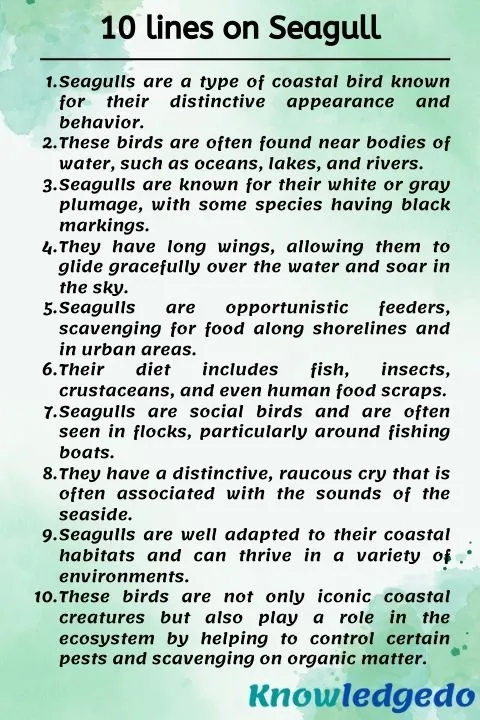Today, we are sharing 10 lines on Seagull in English. This article can help students who are looking for information about 10 lines on Seagulls. These lines are straightforward and easy to remember. The level of difficulty is moderate, making it accessible for any student to write on this topic.
This article is generally useful for class 1,class 2,class 3,class 4,class 5,class 6,class 7,class 8,class 9,class 10,class 11,class 12
10 lines on Seagull
1) Seagulls are a type of coastal bird known for their distinctive appearance and behaviour.
2) These birds are often found near bodies of water, such as oceans, lakes, and rivers.
3) Seagulls are known for their white or grey plumage, with some species having black markings.
4) They have long wings, allowing them to glide gracefully over the water and soar in the sky.
5) Seagulls are opportunistic feeders, scavenging for food along shorelines and in urban areas.
6) Their diet includes fish, insects, crustaceans, and even human food scraps.
7) Seagulls are social birds and are often seen in flocks, particularly around fishing boats.
8) They have a distinctive, raucous cry that is often associated with the sounds of the seaside.
9) Seagulls are well-adapted to their coastal habitats and can thrive in a variety of environments.
10) These birds are not only iconic coastal creatures but also play a role in the ecosystem by helping to control certain pests and scavenging on organic matter.

5 lines on Seagull
1) Seagulls are coastal birds known for their graceful flight and distinctive appearance.
2) They have white or grey feathers, and long wings, and are often spotted near water bodies.
3) Seagulls are opportunistic feeders, scavenging for a variety of foods, including fish and human leftovers.
4) Their loud calls are a familiar sound at the seaside, often associated with the beach.
5) These adaptable birds are not only beachside icons but also vital components of coastal ecosystems.
FAQ
Answer: Seagulls have a varied diet that includes fish, insects, crustaceans, small mammals, and even human food scraps. They are opportunistic feeders.
Answer: Seagulls are coastal birds because they are closely associated with marine environments, feeding on fish and other marine life that are abundant near the coast.
Answer: Yes, many seagull species are migratory. They may travel long distances between breeding and wintering grounds, following seasonal patterns.
Answer: Yes, the term “seagull” is often used informally to refer to various species of gulls. Gulls are a diverse family of birds that includes many species found near the sea.
Answer: Seagull eggs and chicks are vulnerable to predation by larger birds, such as crows and eagles. However, adult seagulls have fewer natural predators.
Answer: Seagulls, like many marine birds, have specialized glands near their eyes that help them excrete excess salt, allowing them to ingest salt water when needed. They primarily rely on fresh water for drinking.
Answer: The protection status of seagulls varies by species and location. In some regions, certain seagull species are protected, while in others, they may be considered pests due to their scavenging behaviour, which can lead to conflicts with humans. It’s important to check local regulations regarding seagulls.
